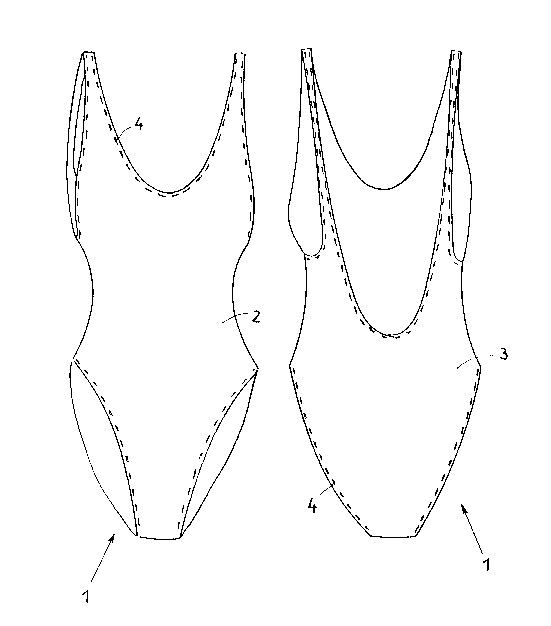Some of the information on this Web page has been provided by external sources. The Government of Canada is not responsible for the accuracy, reliability or currency of the information supplied by external sources. Users wishing to rely upon this information should consult directly with the source of the information. Content provided by external sources is not subject to official languages, privacy and accessibility requirements.
Any discrepancies in the text and image of the Claims and Abstract are due to differing posting times. Text of the Claims and Abstract are posted:
| (12) Patent: | (11) CA 2113811 |
|---|---|
| (54) English Title: | MATERIAL TRANSMITTING SUNLIGHT AND BATHING WEAR AND LIGHT-PROTECTIVE WEAR MADE FROM THE SAME |
| (54) French Title: | ETOFFE TRANSMETTANT LA LUMIERE DU SOLEIL, ET MAILLOT DE BAIN ET VETEMENT PROTEGEANT DE LA LUMIERE FABRIQUES AVEC CETTE ETOFFE |
| Status: | Term Expired - Post Grant Beyond Limit |
| (51) International Patent Classification (IPC): |
|
|---|---|
| (72) Inventors : |
|
| (73) Owners : |
|
| (71) Applicants : |
|
| (74) Agent: | SMART & BIGGAR LP |
| (74) Associate agent: | |
| (45) Issued: | 1996-07-16 |
| (86) PCT Filing Date: | 1993-04-28 |
| (87) Open to Public Inspection: | 1994-01-20 |
| Examination requested: | 1994-01-19 |
| Availability of licence: | N/A |
| Dedicated to the Public: | N/A |
| (25) Language of filing: | English |
| Patent Cooperation Treaty (PCT): | Yes |
|---|---|
| (86) PCT Filing Number: | PCT/EP1993/001024 |
| (87) International Publication Number: | WO 1994001010 |
| (85) National Entry: | 1994-01-19 |
| (30) Application Priority Data: | ||||||
|---|---|---|---|---|---|---|
|
The invention provides bathing wear of a net-like knitted fabric printed with
contrasting bright colours, which is composed of 73 % nylon and 27 % of a
polyurethane elastomer. The knitted fabric has a multiplicity of hexagonal mesh
openings which are aligned in rows in three directions.
This bathing wear allows about two-thirds of the incident UV radiation of the
sun to pass and thus gives rise to full body tanning, without being transparent
however - even when wet. In addition the bathing wear is quick-drying and fits the
body elastically.
Note: Claims are shown in the official language in which they were submitted.
Note: Descriptions are shown in the official language in which they were submitted.

2024-08-01:As part of the Next Generation Patents (NGP) transition, the Canadian Patents Database (CPD) now contains a more detailed Event History, which replicates the Event Log of our new back-office solution.
Please note that "Inactive:" events refers to events no longer in use in our new back-office solution.
For a clearer understanding of the status of the application/patent presented on this page, the site Disclaimer , as well as the definitions for Patent , Event History , Maintenance Fee and Payment History should be consulted.
| Description | Date |
|---|---|
| Inactive: IPC removed | 2022-10-18 |
| Inactive: IPC assigned | 2022-10-18 |
| Inactive: IPC assigned | 2022-10-18 |
| Inactive: First IPC assigned | 2022-10-18 |
| Inactive: IPC assigned | 2022-10-18 |
| Inactive: IPC expired | 2019-01-01 |
| Inactive: Expired (new Act pat) | 2013-04-28 |
| Inactive: Late MF processed | 2009-04-30 |
| Letter Sent | 2009-04-28 |
| Small Entity Declaration Request Received | 2008-04-23 |
| Small Entity Declaration Determined Compliant | 2008-04-23 |
| Inactive: Office letter | 2006-09-29 |
| Appointment of Agent Requirements Determined Compliant | 2006-09-29 |
| Revocation of Agent Requirements Determined Compliant | 2006-09-29 |
| Inactive: Office letter | 2006-09-29 |
| Letter Sent | 2006-09-28 |
| Revocation of Agent Request | 2006-08-22 |
| Appointment of Agent Request | 2006-08-22 |
| Inactive: IPC from MCD | 2006-03-11 |
| Grant by Issuance | 1996-07-16 |
| Application Published (Open to Public Inspection) | 1994-01-20 |
| Request for Examination Requirements Determined Compliant | 1994-01-19 |
| All Requirements for Examination Determined Compliant | 1994-01-19 |
There is no abandonment history.
| Fee Type | Anniversary Year | Due Date | Paid Date |
|---|---|---|---|
| MF (patent, 5th anniv.) - standard | 1998-04-28 | 1998-03-02 | |
| MF (patent, 6th anniv.) - standard | 1999-04-28 | 1999-03-18 | |
| MF (patent, 7th anniv.) - standard | 2000-04-28 | 2000-03-01 | |
| MF (patent, 8th anniv.) - standard | 2001-04-30 | 2001-03-12 | |
| MF (patent, 9th anniv.) - standard | 2002-04-29 | 2002-03-18 | |
| MF (patent, 10th anniv.) - standard | 2003-04-28 | 2003-03-17 | |
| MF (patent, 11th anniv.) - standard | 2004-04-28 | 2004-03-25 | |
| MF (patent, 12th anniv.) - standard | 2005-04-28 | 2005-04-07 | |
| MF (patent, 13th anniv.) - standard | 2006-04-28 | 2006-04-11 | |
| Registration of a document | 2006-08-18 | ||
| MF (patent, 14th anniv.) - standard | 2007-04-30 | 2007-04-20 | |
| MF (patent, 15th anniv.) - small | 2008-04-28 | 2008-04-23 | |
| Reversal of deemed expiry | 2009-04-28 | 2009-04-30 | |
| MF (patent, 16th anniv.) - small | 2009-04-28 | 2009-04-30 | |
| MF (patent, 17th anniv.) - small | 2010-04-28 | 2010-04-28 | |
| MF (patent, 18th anniv.) - small | 2011-04-28 | 2011-04-28 | |
| MF (patent, 19th anniv.) - small | 2012-04-30 | 2012-04-30 |
Note: Records showing the ownership history in alphabetical order.
| Current Owners on Record |
|---|
| SILVER SUNBEAM LIMITED |
| Past Owners on Record |
|---|
| HERBERT RIEDEL |